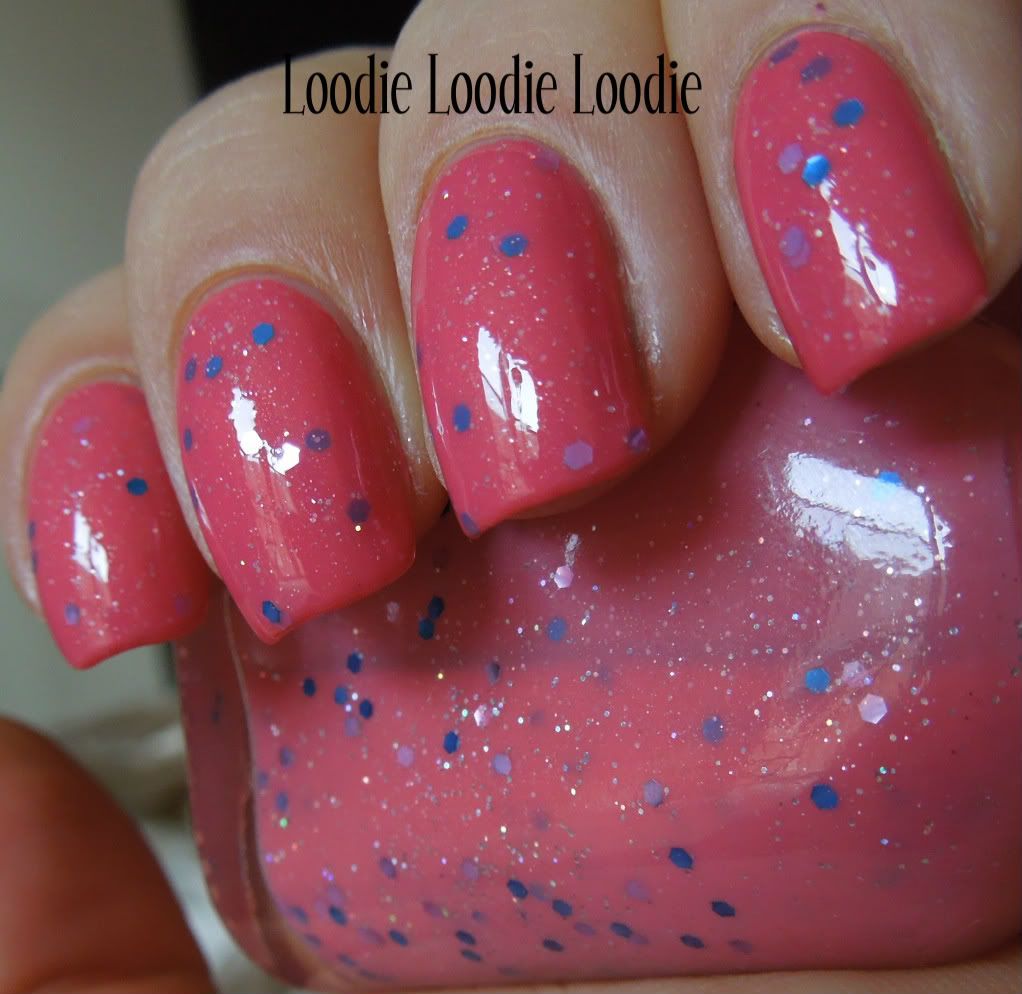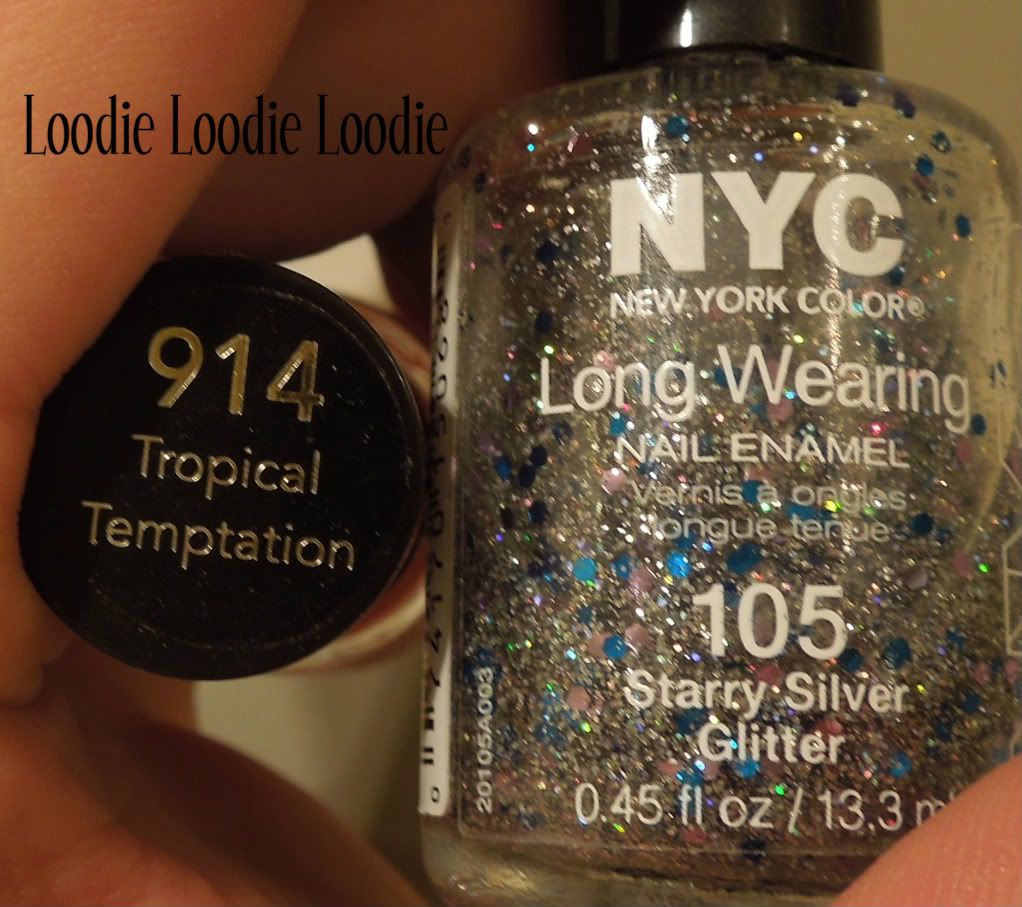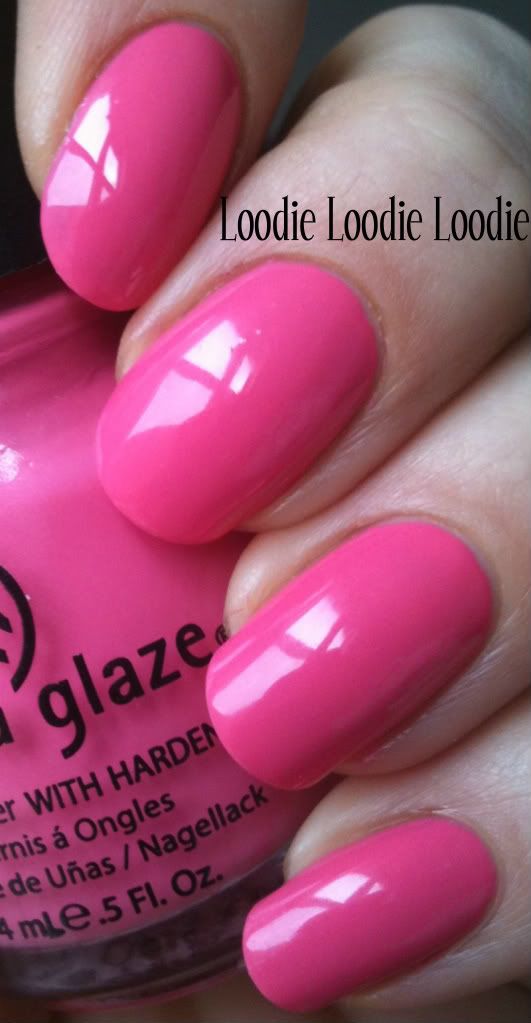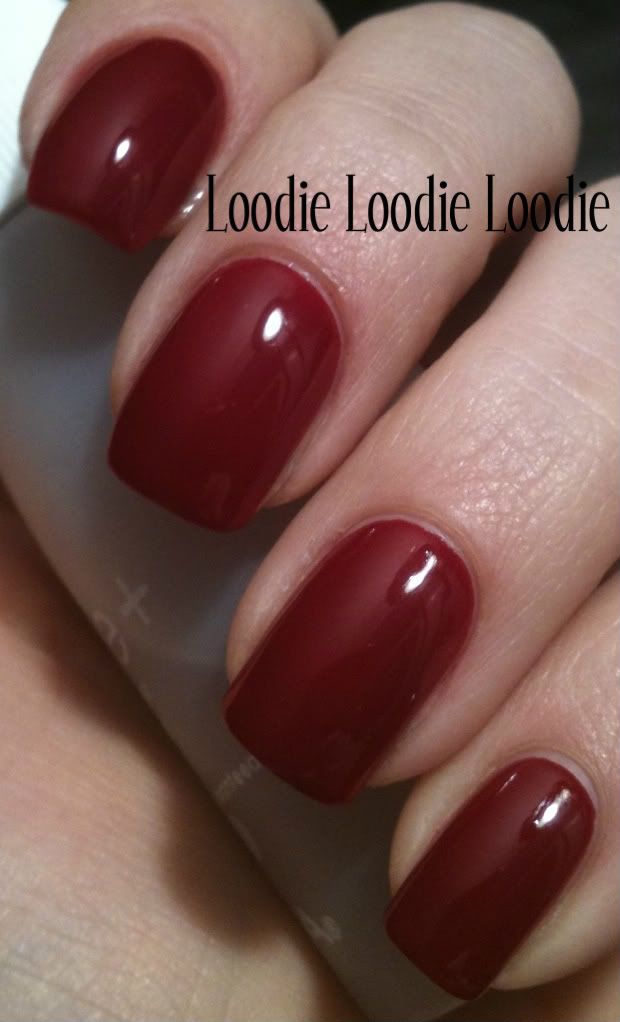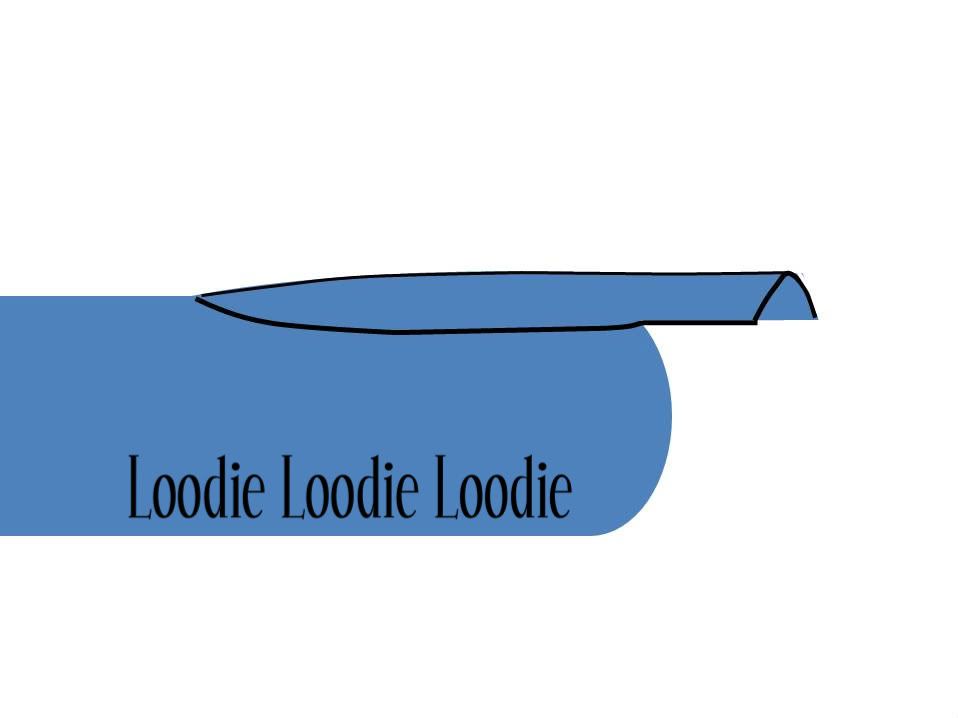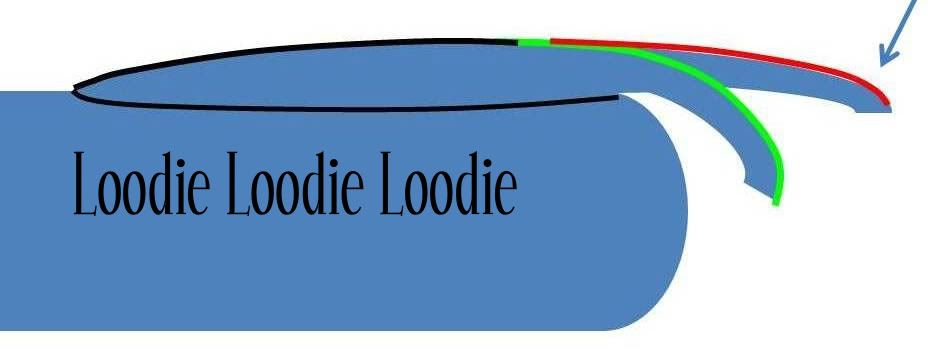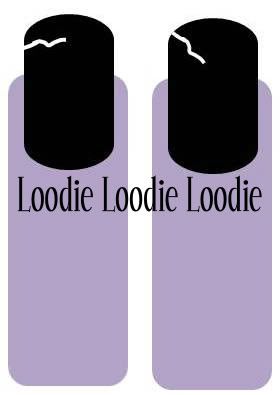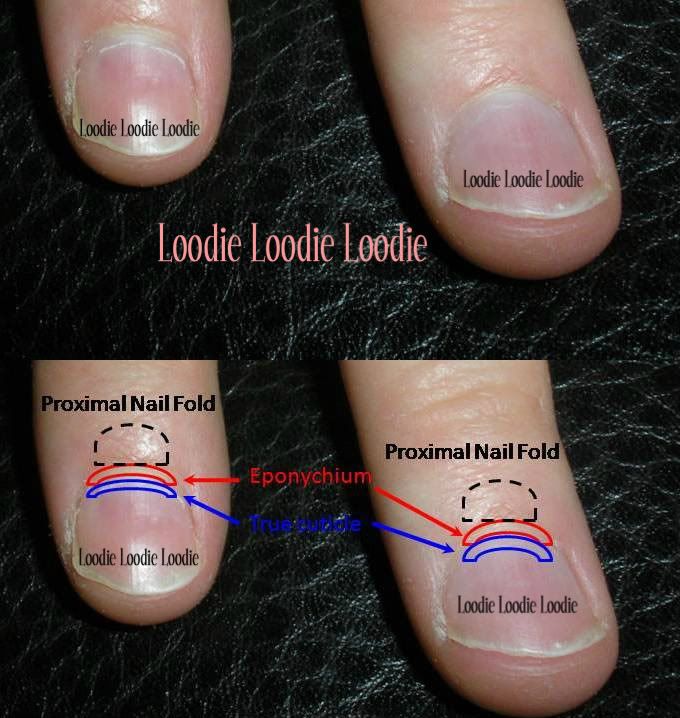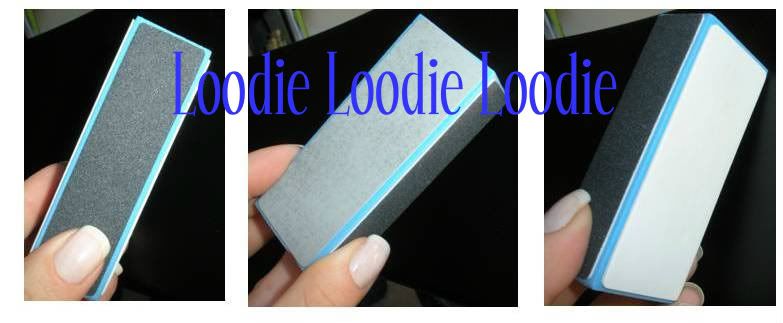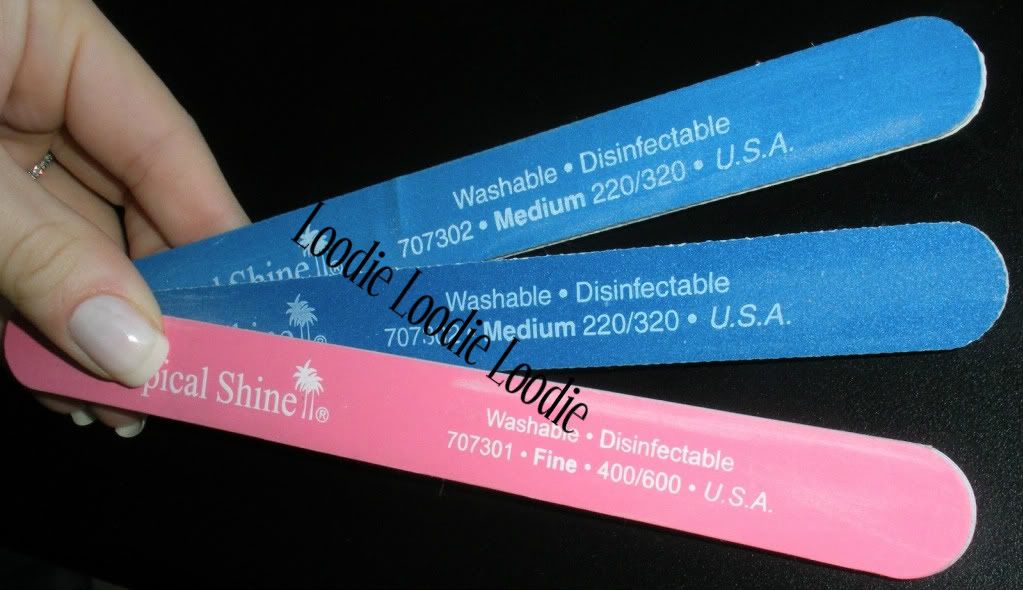I never understood why the directions on some nail treatments called for an extra coat everyday or every other day. Are you suggesting your miracle juice is able to penetrate through the layer (or four) I put on in the previous few days?! That would be fantastic! However, I'm a beauty skeptic, remember? Once the product is dry, can more product absorb through and penetrate the nail?
The following is my brain daydreaming...
I imagine after a polish has dried (or cured) it can have small pores (or cracks). That, I can accept. Whether it actually happens is another question. However, I do remember seeing the following video explaining how soak off gels work, which supports the mere possibility in regular polish.
In this situation, a chemical solvent (or perhaps the word molecule may be more appropriate) seeps through these engineered cracks or pores and is able to reach the dissolvable portion of the product. Is this possible for regular polish or treatments?
Let's assume the mere possibility:
My mind can imagine such a process for treatment products. Perhaps after the first layer has dried/cured enough cracks or pores exist and the treatment molecules are small enough to fit through and make it to the nail nail surface. However, how likely would it be that companies actually engineer their treatment products like this? I have no idea.
Now let's assume this does NOT occur with regular polish and treatments:
There are two main reasons I can think of for these directions to exist, both are purely based on my gut and experience. My guess is they have you reapply the product merely as a coat of physical protection, which in reality any decent base coat or topcoat can provide (it's likely more cost effective too).
The other thought I had was, these directions are a marketing/selling tool. They make the consumer feel like they are doing something everyday to help their nail situation. Meanwhile, more of the product is used up, forcing the consumer to buy more to sustain their results. In the end the consumer feels like they have really contributed to their nail health (yay accomplishment!), while the company is ecstatic over their bottom line (they probably get a party with fancy champagne and hors d'œuvres *jealous*).
I like to beat the system. Ya know, stick it to the man! Treatments that come as a lacquer, I generally only apply to the actual nail surface. All other subsequent coats would either be a base coat or topcoat, depending on whether I already applied colored polish.
Summary:
This is all just me thinking aloud. I have no proof of anything. I wish I could be more concrete, but until I learn something new, I say don't waste your expensive treatment products as extra layers.
As a reward for making it all the way to the bottom of this post I'll show you meat and a franken:
Because who doesn't like meat in their mouth, duh!
Prosciutto.
The franken!
Really easy to make!
I used Revlon - Tropical Temptation and NYC - Starry Silver Glitter.
I've swatched Revlon - Tropical Temptation here. It somewhat resembles Revlon - Make Mine Mango here.
I have a Nail Treatment/Hardener Series, click here.
Nails, Life, and more nails. Not so much a nail polish obsession, but more of a nail care obsession.
Nail Hardeners and Treatments
Showing posts with label Series. Show all posts
Showing posts with label Series. Show all posts
Tuesday, May 8, 2012
Beat the system!
Labels:
Franken,
Glitter,
How to,
Nail Hardeners,
Pink,
Series,
Treatments,
Tutorial,
YouTube
Tuesday, February 28, 2012
Blending ... not just for makeup.
I don't know what it is about round/oval nails on my hands that just seems off. They seem to look elegant at some angles, while other times I'm just like, "what is going on here?" I am constantly doing double takes perhaps because my brain is so accustomed to the squoval. As a result, I filed my nails back into a more mentally acceptable shape for me, squoval. I made a short video in the process.
How to file your nails into a Squoval from Round/Oval:
All you have to do is create a flat top and rounded edges. Then, blend the two together to your desired level of squovalness.
The rest of the filing series can be found below:
X-Files Post and Video
Nail Shape and Balance Post
Taking Down Nail Length Post
Shaping the Free Edge - Square and Video
Shaping the Free Edge - Oval and Video
Shaping the Free Edge - Squoval and Video
Sealing the Nail Plate
Buffing out a peel
The polish in the video was ...
China Glaze - Sugar High
At the end ...
China Glaze - High Maintenance
Do you have a mental inability to accept certain nail shapes? What nail shape does your brain favor?
How to file your nails into a Squoval from Round/Oval:
All you have to do is create a flat top and rounded edges. Then, blend the two together to your desired level of squovalness.
The rest of the filing series can be found below:
X-Files Post and Video
Nail Shape and Balance Post
Taking Down Nail Length Post
Shaping the Free Edge - Square and Video
Shaping the Free Edge - Oval and Video
Shaping the Free Edge - Squoval and Video
Sealing the Nail Plate
Buffing out a peel
The polish in the video was ...
China Glaze - Sugar High
At the end ...
China Glaze - High Maintenance
Do you have a mental inability to accept certain nail shapes? What nail shape does your brain favor?
Labels:
China Glaze,
How to,
Pink,
Ready Set File,
Red,
Round,
Series,
Squoval,
Tutorial,
Video's,
YouTube
Sunday, July 24, 2011
Hello New Loodie!
Hello New People!
If you're new to my blog you may have missed a few interesting posts. I thought I would summarize a few interesting series and/or topics:
Nail Filing Series:
X-Files Post and Video
Nail Shape and Balance Post
Taking Down Nail Length Post
Shaping the Free Edge - Square Post and Video
Shaping the Free Edge - Oval Post and Video
Shaping the Free Edge - Squoval Post and Video
Sealing the Nail Plate
Buffing out a peel
Nail Hardener/Treatment Series:
Nail Hardener/Treatment Categories
Formaldehyde Nail Treatments
Are Formaldehyde Based Treatments right for you?
Protein Based Treatments
Formaldehyde + Protein Based Hardeners
Formaldehyde or Protein Based Hardeners + Moisturizers
Fluoride Based Nail Treatments Part I
Fluoride Based Nail Treatments Part II
Dimethyl Urea (DMU) based Hardeners
I have had so many new followers I thought I would say 'hey' and 'WELCOME'! *waves spastically* :D
Many thanks to the other nail ladies in the nail community for their love and support ... especially Polish Insomniac and Rebecca likes nails. <3
Many thanks to the other nail ladies in the nail community for their love and support ... especially Polish Insomniac and Rebecca likes nails. <3
If you're new to my blog you may have missed a few interesting posts. I thought I would summarize a few interesting series and/or topics:
Nail Filing Series:
X-Files Post and Video
Nail Shape and Balance Post
Taking Down Nail Length Post
Shaping the Free Edge - Square Post and Video
Shaping the Free Edge - Oval Post and Video
Shaping the Free Edge - Squoval Post and Video
Sealing the Nail Plate
Buffing out a peel
Nail Hardener/Treatment Series:
Nail Hardener/Treatment Categories
Formaldehyde Nail Treatments
Are Formaldehyde Based Treatments right for you?
Protein Based Treatments
Formaldehyde + Protein Based Hardeners
Formaldehyde or Protein Based Hardeners + Moisturizers
Fluoride Based Nail Treatments Part I
Fluoride Based Nail Treatments Part II
Dimethyl Urea (DMU) based Hardeners
Nail Conditioners, and more nail conditioner talk here
Formaldehyde vs. Formaldhehyde Resin
Cuticle Care:
Moisture
More Moisture
Cuticles - to cut or not to cut
How to use cuticle remover
Nail Fix Series:
Gel polish to the rescue!
General Nail Care Tips:
Rules to live by
Formaldehyde vs. Formaldhehyde Resin
Cuticle Care:
Moisture
More Moisture
Cuticles - to cut or not to cut
How to use cuticle remover
Nail Fix Series:
Gel polish to the rescue!
General Nail Care Tips:
Rules to live by
Saturday, December 4, 2010
Nail Hardeners: Are formaldehyde based hardeners right for you?
I received an email recently from Cristina (from the MUA nail boards) that made me realize I needed to add some information to the Formaldehyde based Nail Hardener post. Check that one out first if you haven't already. The concern in this email was about the safety of formaldehyde based hardeners as well as whether it was the right hardener to use.
First safety:
Usually the amount of formaldehyde in these types of hardeners is 1-3% and they are ALL safe at this level. The only safety issue that I can foresee is allergy related, but at these low concentrations this is usually not a problem. It's a good idea, however, to avoid skin contact to prevent irritation. If you are allergic, so be it and avoid it altogether, before anaphylactic shock sets in ... yikes.
Since these hardeners are relatively safe, I think the next main concern is whether your nail condition needs this type of nail hardener.
Is Formaldehyde based hardener right for you:
Each person considering a nail hardener needs to evaluate the condition of their nails at the moment. Are your nails soft or hard? Thin or thick? Peeling or cracking? Once you know where you stand you can decide if "formaldehyde based" is suitable for you.
What do I mean by soft or hard?
Are your nails really pliable? When you push down on your nails free edge does it bend easily without much resistance or pretty solid? Check out the schematics to help you determine the answers:
What? You don't have blue fingers? hee hee, I just realized the blue after I made it and it took forever so you'll just have to accept it. Anyway, let's pretend this is a normal nail at rest.
If you can push down on your nails free edge and it bends easily without much resistance, like the green, they are probably soft. If they provide some resistance, like the red, they are hard. Of course you can have some variability and call it something in between. This is just a guide.
What do I mean by thin or thick?
Pretty self explanatory, I hope.
What do I mean by peeling or cracking?
This shows peeling. (thanks to google)
This is cracking.
I couldn't find a good picture of cracking so this schematic will also have to do. I hate cracks that happened horizontally below the free edge, big ouch. I will put a link here soon, about my preferred method of fixing such a catastrophe.
Formaldehyde based hardeners are best for soft, peeling thin nails. Your nail plate is made up of a protein called keratin. Keratin is fibrous and has naturally occurring cross linkages between the filaments. Formaldehyde reacts with the keratin in your nail plate and increases the cross linkages between these fibers. As a result, the nail plate becomes harder. These linkages prevent peeling by linking more of the nail plate layers together and makes the nail plate thicker (imagine how thicker those nails in that picture above would be if the nail plate was all fused together and not sloughing off).
There is nothing wrong with formaldehyde based hardeners, as I have already mentioned in the last post, but too many cross links in the keratin causes nail plate brittleness. Some brands have higher concentrations of formaldehyde than others (usually these are trade secrets) and overuse can cause brittleness; therefore, I generally suggest intermittent use of these types of treatments. That way you can get the desired hardness, then back off so the nail doesn't get too brittle.
If your nails are cracking this could be a sign that your nails are already hard (with plenty of cross linkages in the keratin) but lack flexibility. A formaldehyde based hardener may not be a good idea. Instead, a good moisturizer (oil/balms/butter/cuticle creams) needs to be used frequently throughout the day. A different type of treatment should probably be considered if moisturizing alone doesn't do the trick. More on that in a later post.
If you have thick nails I give you a high five. Nothing wrong with that, except make sure its not some underlying fungus condition. Otherwise, the only down side is more work filing.
If another combination describes your nails condition, for example: soft and dry (I would imagine this on thin problem nails), then another treatment or combination of treatments may be right for you. I will cover this in greater detail as I go through the different treatments in the series.
A few final words. Whichever treatment you choose, keep in mind that they all takes time to see results. The damaged nail plate has to grow out and the new treated nail plate will eventually surface. The nail plate may take a full six months to grow out from the cuticle to the nail tip.
I hope this addition is helpful to the series.
Edit: There is a difference between formaldehyde and formaldehyde resin. That post can be found here.
Next post : Protein Nail Treatments
The complete series:
Categories of Hardeners and Formaldehyde
Are Formaldehyde Hardeners right for you?
Protein Based Hardeners
Formaldehyde + Protein Based Hardeners
Formaldehyde or Protein Based Hardeners + Moisturizers
Fluoride Based Nil Treatments Part I
Fluoride Based Nail Treatments Part II
Dimethyl Urea Base Hardeners
Nail Conditioners Post or Video Review of DermaNail
Formaldehyde vs. Formaldehyde Resin
First safety:
Usually the amount of formaldehyde in these types of hardeners is 1-3% and they are ALL safe at this level. The only safety issue that I can foresee is allergy related, but at these low concentrations this is usually not a problem. It's a good idea, however, to avoid skin contact to prevent irritation. If you are allergic, so be it and avoid it altogether, before anaphylactic shock sets in ... yikes.
Since these hardeners are relatively safe, I think the next main concern is whether your nail condition needs this type of nail hardener.
Is Formaldehyde based hardener right for you:
Each person considering a nail hardener needs to evaluate the condition of their nails at the moment. Are your nails soft or hard? Thin or thick? Peeling or cracking? Once you know where you stand you can decide if "formaldehyde based" is suitable for you.
What do I mean by soft or hard?
Are your nails really pliable? When you push down on your nails free edge does it bend easily without much resistance or pretty solid? Check out the schematics to help you determine the answers:
What? You don't have blue fingers? hee hee, I just realized the blue after I made it and it took forever so you'll just have to accept it. Anyway, let's pretend this is a normal nail at rest.
If you can push down on your nails free edge and it bends easily without much resistance, like the green, they are probably soft. If they provide some resistance, like the red, they are hard. Of course you can have some variability and call it something in between. This is just a guide.
What do I mean by thin or thick?
Pretty self explanatory, I hope.
What do I mean by peeling or cracking?
This shows peeling. (thanks to google)
This is cracking.
I couldn't find a good picture of cracking so this schematic will also have to do. I hate cracks that happened horizontally below the free edge, big ouch. I will put a link here soon, about my preferred method of fixing such a catastrophe.
Formaldehyde based hardeners are best for soft, peeling thin nails. Your nail plate is made up of a protein called keratin. Keratin is fibrous and has naturally occurring cross linkages between the filaments. Formaldehyde reacts with the keratin in your nail plate and increases the cross linkages between these fibers. As a result, the nail plate becomes harder. These linkages prevent peeling by linking more of the nail plate layers together and makes the nail plate thicker (imagine how thicker those nails in that picture above would be if the nail plate was all fused together and not sloughing off).
There is nothing wrong with formaldehyde based hardeners, as I have already mentioned in the last post, but too many cross links in the keratin causes nail plate brittleness. Some brands have higher concentrations of formaldehyde than others (usually these are trade secrets) and overuse can cause brittleness; therefore, I generally suggest intermittent use of these types of treatments. That way you can get the desired hardness, then back off so the nail doesn't get too brittle.
If your nails are cracking this could be a sign that your nails are already hard (with plenty of cross linkages in the keratin) but lack flexibility. A formaldehyde based hardener may not be a good idea. Instead, a good moisturizer (oil/balms/butter/cuticle creams) needs to be used frequently throughout the day. A different type of treatment should probably be considered if moisturizing alone doesn't do the trick. More on that in a later post.
If you have thick nails I give you a high five. Nothing wrong with that, except make sure its not some underlying fungus condition. Otherwise, the only down side is more work filing.
If another combination describes your nails condition, for example: soft and dry (I would imagine this on thin problem nails), then another treatment or combination of treatments may be right for you. I will cover this in greater detail as I go through the different treatments in the series.
A few final words. Whichever treatment you choose, keep in mind that they all takes time to see results. The damaged nail plate has to grow out and the new treated nail plate will eventually surface. The nail plate may take a full six months to grow out from the cuticle to the nail tip.
I hope this addition is helpful to the series.
Edit: There is a difference between formaldehyde and formaldehyde resin. That post can be found here.
Next post : Protein Nail Treatments
The complete series:
Categories of Hardeners and Formaldehyde
Are Formaldehyde Hardeners right for you?
Protein Based Hardeners
Formaldehyde + Protein Based Hardeners
Formaldehyde or Protein Based Hardeners + Moisturizers
Fluoride Based Nil Treatments Part I
Fluoride Based Nail Treatments Part II
Dimethyl Urea Base Hardeners
Nail Conditioners Post or Video Review of DermaNail
Formaldehyde vs. Formaldehyde Resin
Labels:
Formaldehyde,
How to,
Nail Hardeners,
Series,
Treatments,
Tutorial
Wednesday, December 1, 2010
In a pinch
I always stress moisturizing the cuticle area and nails because, in my opinion, this is one of the most important factors in nail health. By balancing nail hardness with flexibility we can help eliminate peeling, cracking, breaking and promote healthy long nail growth.
It's good to keep some sort of nail moisturizer within reach where ever you happen to be. Home, work, bedside, book bag, purse, jacket pocket, you get the picture.
One day I was on a long car ride and threw my bag and jacket in the trunk. My nails were feeling really dry and I was suddenly in a real pinch. What to do???
I checked my jean pockets and found chap-stick.
I said what the hell lets check out the ingredients!
They are:
Ethylhexyl Palmitate, Ceresin, Beeswax, Squalane, Jojoba Oil, Shea Butter, Sweet Almond Oil, Vitamine E, Phenoxyethanol.
I have to admit, I had no idea what the first two and last ingredients were, but my thought was if they are okay for my mouth, they were more than okay for my fingers. I was very familiar with the other ingredients as either moisturizers or moisture sealants, so I didn't hesitate any further. I scraped some off and went to town.
For any other nerds out there, I later found out that ethylhexyl palmitate is used primarly as a solvent/carrying agent/emollient, Ceresin is a wax, and Phenoxyethanol is used to kill bacteria.
What a great substitute in a pinch, but not a replacement for a good moisturizer as I have discussed previously.
It's good to keep some sort of nail moisturizer within reach where ever you happen to be. Home, work, bedside, book bag, purse, jacket pocket, you get the picture.
One day I was on a long car ride and threw my bag and jacket in the trunk. My nails were feeling really dry and I was suddenly in a real pinch. What to do???
I checked my jean pockets and found chap-stick.
I said what the hell lets check out the ingredients!
They are:
Ethylhexyl Palmitate, Ceresin, Beeswax, Squalane, Jojoba Oil, Shea Butter, Sweet Almond Oil, Vitamine E, Phenoxyethanol.
I have to admit, I had no idea what the first two and last ingredients were, but my thought was if they are okay for my mouth, they were more than okay for my fingers. I was very familiar with the other ingredients as either moisturizers or moisture sealants, so I didn't hesitate any further. I scraped some off and went to town.
For any other nerds out there, I later found out that ethylhexyl palmitate is used primarly as a solvent/carrying agent/emollient, Ceresin is a wax, and Phenoxyethanol is used to kill bacteria.
What a great substitute in a pinch, but not a replacement for a good moisturizer as I have discussed previously.
Labels:
Cuticle Care,
How to,
Moisturizer,
Series,
Tutorial
Tuesday, November 23, 2010
Nail Hardeners
The wonderful world of nail treatments. Boy back in the day this was it for me. I loved trying new products, but since I was a tween/teen/young adult without moola, I would buy one treatment at a time. I used to save my lunch money, yes we are talking starving for nail polish, and stand in the makeup isle at Wal-mart/CVS/Sally's for hours, reading each and every bottle over and over (ingredients, claims, etc) trying to decide which product would be magic to my nails. I always used up every bottle and often repurchased to see how and if the ingredients did their magic. I wanted to know what each ingredient did. What a weirdo, I know, but now I can tell you what I learned.
I think one of the biggest questions out there is, what is the best nail hardener? The answer is not a simple one, but this series of posts will try to rationalize the possibilities. This entire series assumes your overall health is good, because no topical nail treatment can help you if you have some underlying illness.
Another very important factor to remember is that nail hardness is not the same thing as flexibility. Hard nails are great because they are strong, but there is such a thing as over hardening the nail plate. The harder that your nails get the more brittle they become. The nail plate must balance both characteristics, hardness and flexibility, to retain health, stability, and length. We can balance the hardness with nail flexibility by moisturizing and taking a break from nail hardeners intermittently if needed (that depends on the type you use)! Furthermore, you will find the healthier the nail plate the longer you nail polish will last (that is if you want it to).
There are, in my mind, only 6 categories of nail hardeners because each category of nail hardener works in essentially the same way.
1. Formaldehyde based - this post and here.
2. Formaldehyde free, protein based
3. A mix of #1. and #2 ... post here.
4. There are three subcategories: post here.
a.) #1 with conditioners, b.) #2 with conditioners, or c.) #3 with conditioners: all here
5. Fluoride based, Part I and Part II
6. Dimethyl Urea based
....................................................
7. Nail Conditioner - DermaNail ( or NeoCeuticals Nail Conditioning Solution)
Video Review for DermaNail
#7 is different, I have not encountered anything else like it on the market.
I would encourage everyone to start reading the ingredients of all your nail products, especially nail treatments, so that you can eliminate similar class products that have not worked for you. I will take you through the different categories and how they work. Although, I may mention a few brand names from each category, I do not favor any, rather I favor categories. Personally, I like #2, #5, and #7.
Formaldehyde based nail hardeners:
Your nail bed is comprised of a protein called keratin. This protein has naturally occurring cross linkages which give nails their hardness. However, not enough cross-links and the nail is very flexible and lacks strength. One way to create more cross-links in keratin is with the use of formaldehyde.
Formaldehyde based nail hardeners are the most common type of nail hardener and contain 1-3 % formaldehyde. (Note: Formaldehyde is not the same as Formaldehyde Resin) Formaldehyde reacts with keratin and creates more cross-linkages. Bottom line - they work. However, I have two main hang up's with this category.
1. Overtime and overuse of formaldehyde based hardeners causes the keratin to form too many cross-links and as a result the nail becomes very hard, looses its flexibility and becomes brittle.
2. Formaldehyde is a skin irritant and overtime people can build up an allergy. Skin contact should be avoided.
Overall, these hardeners work, but should be used intermittently to avoid brittle nails and possible worsening of your nail's condition (i.e. more chipping, peeling, etc.). And as always, moisturizer should play an important role in nail maintenance.
EXAMPLES: Do check ingredients to make sure formula's didn't change!
- Nail Tek is a popular brand that salons may recommend
- OPI makes Nail Envy
- There are many many more! Pretty much each brand name has one.
- I have also seen nail hardeners (off brand) at the dollar store, just check the ingredients.
Next up: Are formaldehyde based nail hardeners right for you?
I think one of the biggest questions out there is, what is the best nail hardener? The answer is not a simple one, but this series of posts will try to rationalize the possibilities. This entire series assumes your overall health is good, because no topical nail treatment can help you if you have some underlying illness.
Another very important factor to remember is that nail hardness is not the same thing as flexibility. Hard nails are great because they are strong, but there is such a thing as over hardening the nail plate. The harder that your nails get the more brittle they become. The nail plate must balance both characteristics, hardness and flexibility, to retain health, stability, and length. We can balance the hardness with nail flexibility by moisturizing and taking a break from nail hardeners intermittently if needed (that depends on the type you use)! Furthermore, you will find the healthier the nail plate the longer you nail polish will last (that is if you want it to).
There are, in my mind, only 6 categories of nail hardeners because each category of nail hardener works in essentially the same way.
1. Formaldehyde based - this post and here.
2. Formaldehyde free, protein based
3. A mix of #1. and #2 ... post here.
4. There are three subcategories: post here.
a.) #1 with conditioners, b.) #2 with conditioners, or c.) #3 with conditioners: all here
5. Fluoride based, Part I and Part II
6. Dimethyl Urea based
....................................................
7. Nail Conditioner - DermaNail ( or NeoCeuticals Nail Conditioning Solution)
Video Review for DermaNail
#7 is different, I have not encountered anything else like it on the market.
I would encourage everyone to start reading the ingredients of all your nail products, especially nail treatments, so that you can eliminate similar class products that have not worked for you. I will take you through the different categories and how they work. Although, I may mention a few brand names from each category, I do not favor any, rather I favor categories. Personally, I like #2, #5, and #7.
Formaldehyde based nail hardeners:
Your nail bed is comprised of a protein called keratin. This protein has naturally occurring cross linkages which give nails their hardness. However, not enough cross-links and the nail is very flexible and lacks strength. One way to create more cross-links in keratin is with the use of formaldehyde.
Formaldehyde based nail hardeners are the most common type of nail hardener and contain 1-3 % formaldehyde. (Note: Formaldehyde is not the same as Formaldehyde Resin) Formaldehyde reacts with keratin and creates more cross-linkages. Bottom line - they work. However, I have two main hang up's with this category.
1. Overtime and overuse of formaldehyde based hardeners causes the keratin to form too many cross-links and as a result the nail becomes very hard, looses its flexibility and becomes brittle.
2. Formaldehyde is a skin irritant and overtime people can build up an allergy. Skin contact should be avoided.
Overall, these hardeners work, but should be used intermittently to avoid brittle nails and possible worsening of your nail's condition (i.e. more chipping, peeling, etc.). And as always, moisturizer should play an important role in nail maintenance.
EXAMPLES: Do check ingredients to make sure formula's didn't change!
- Nail Tek is a popular brand that salons may recommend
- OPI makes Nail Envy
- There are many many more! Pretty much each brand name has one.
- I have also seen nail hardeners (off brand) at the dollar store, just check the ingredients.
Next up: Are formaldehyde based nail hardeners right for you?
Labels:
Formaldehyde,
How to,
Nail Hardeners,
Series,
Treatments,
Tutorial
Friday, November 19, 2010
Are you a cutter?!
To cut or not to cut cuticles? That is the question. This question always seems to divide the MUA nail boards and raises up a storm of answers.
I feel like one day we might battle .... the cutter's in one corner, ready to slice em and the non-cutters in the other corner ready to spray with cuticle remover. How can we end this controversy??!! Dare I say it ... I think I have an answer to make both parties happy ... but, it's not a short one.
I think there is a lot of misinformation or misunderstanding out there. The bottom line is, the normal person either doesn't know or understand nail anatomy and wrongly identifies the "cuticle". So lets all get on the same page. The graphic below shows some nail parts. We only need to concentrate on a couple terms at the moment.
The cuticle is comprised of living and dead tissue. There are two thin skin strips between the nail tip (distal edge) and the proximal nail fold. The skin strip closest to the proximal nail fold is called the eponychium and is alive, while the skin that grows on the nail plate is dead and is considered the true cuticle; it is located right underneath the eponychium. So, just to summarize and finally clear the air, when we refer to the cuticle we are referring to the "true cuticle" (dead tissue) and not the "eponychium" (live tissue).
Warning: Google image eponychium at your own risk ... it's mega gross!
With that said, it is completely safe to remove the dead cuticle (true cuticle). Notice I said "remove" and not cut. You should choose which ever method you are most comfortable with.
It's no fun unless we have real pictures of fingers so, lets take a look of what to expect on your own fingers.
My husband was nice enough to be provide his nasty fingers for today's viewing. Yes, I said nasty. He won't let me fix them, so the consequence is of course name calling.
The top image shows just the fingers and the bottom has all the parts labeled. Look at the finger on the top left, I have slightly pushed back the true cuticle so you can see it (clearly more crusty white). If you look very carefully to the finger on your top right you may just be able to see the true cuticle. The true cuticle can be pushed back all the way to the eponychium, removing it thereafter can be done by trimming or with a cuticle remover.
Do your own research online and check out your own fingers. If you are unsure about what is what, go to a reputable manicurist and get a manicure. (I stress reputable!) I am sure they would be willing to show you where your cuticle is since this is what they learned in school.
A couple of points I want to make:
1. Cutting the true cuticle is fine as long as you are confident in what you are trimming off.
2. Cutting the eponychium (or any live skin) can lead to infection, not to mention ragged cuticles.
3. Not everyone needs to cut their cuticles, this depends on what they have going on down there. Sometimes a cuticle remover is all that is necessary.
3. Simply pushing back the true cuticles would be a good start. AND don't forget to moisturize!
I will eventually post how to remove cuticles both by cutting/trimming and with a cuticle remover. Stay tuned!
Post about using cuticle remover can be found here.
My final words of caution .... Be careful before you start cutting away or you may end up like some of those Google images for eponychium .... gross!
I feel like one day we might battle .... the cutter's in one corner, ready to slice em and the non-cutters in the other corner ready to spray with cuticle remover. How can we end this controversy??!! Dare I say it ... I think I have an answer to make both parties happy ... but, it's not a short one.
I think there is a lot of misinformation or misunderstanding out there. The bottom line is, the normal person either doesn't know or understand nail anatomy and wrongly identifies the "cuticle". So lets all get on the same page. The graphic below shows some nail parts. We only need to concentrate on a couple terms at the moment.
The cuticle is comprised of living and dead tissue. There are two thin skin strips between the nail tip (distal edge) and the proximal nail fold. The skin strip closest to the proximal nail fold is called the eponychium and is alive, while the skin that grows on the nail plate is dead and is considered the true cuticle; it is located right underneath the eponychium. So, just to summarize and finally clear the air, when we refer to the cuticle we are referring to the "true cuticle" (dead tissue) and not the "eponychium" (live tissue).
Warning: Google image eponychium at your own risk ... it's mega gross!
With that said, it is completely safe to remove the dead cuticle (true cuticle). Notice I said "remove" and not cut. You should choose which ever method you are most comfortable with.
It's no fun unless we have real pictures of fingers so, lets take a look of what to expect on your own fingers.
My husband was nice enough to be provide his nasty fingers for today's viewing. Yes, I said nasty. He won't let me fix them, so the consequence is of course name calling.
The top image shows just the fingers and the bottom has all the parts labeled. Look at the finger on the top left, I have slightly pushed back the true cuticle so you can see it (clearly more crusty white). If you look very carefully to the finger on your top right you may just be able to see the true cuticle. The true cuticle can be pushed back all the way to the eponychium, removing it thereafter can be done by trimming or with a cuticle remover.
Do your own research online and check out your own fingers. If you are unsure about what is what, go to a reputable manicurist and get a manicure. (I stress reputable!) I am sure they would be willing to show you where your cuticle is since this is what they learned in school.
A couple of points I want to make:
1. Cutting the true cuticle is fine as long as you are confident in what you are trimming off.
2. Cutting the eponychium (or any live skin) can lead to infection, not to mention ragged cuticles.
3. Not everyone needs to cut their cuticles, this depends on what they have going on down there. Sometimes a cuticle remover is all that is necessary.
3. Simply pushing back the true cuticles would be a good start. AND don't forget to moisturize!
I will eventually post how to remove cuticles both by cutting/trimming and with a cuticle remover. Stay tuned!
Post about using cuticle remover can be found here.
My final words of caution .... Be careful before you start cutting away or you may end up like some of those Google images for eponychium .... gross!
Labels:
Cuticle Care,
Eponychium,
How to,
Naked Nails,
Series,
True Cuticle,
Tutorial
Thursday, November 18, 2010
Ready, Set, FILE! Taking down length
So far, I have told you a brick wall is not a proper filing implement and filing after you have pruned yourself in the bathtub is also a bad idea. I want to do a series of posts for successful filing of "normal healthy nails." This is the first of that set. This post will specifically cover how to take down nail length, specific nail shapes are covered here, while sealing the nail plate is covered here.
What do I consider a "normal healthy nail?" It's when you DON'T have flaking, peeling, or tearing. How to handle/file an occasional peel is covered in this post. How to handle breaks or tears, especially on the side of the nail wall are covered in this post.
There are several ways to take down nail length. If you have significant growth (>1cm) I would recommend nice sharp clippers: otherwise, follow the steps below.
1. It is best to start filing nails when they are in a normal dry state WITH polish on. If you just took a shower/bath, did the dishes, or soaked your nails from a regular mani (which I don't recommend, more on that in this post*link*), apply moisturizer and let them dry thoroughly. Leaving polish on your nails while filing will prevent and protect the nail from shredding or ripping due to over zealous filing (see #2). Additionally, if you are wearing a dark color your nail shape is much more visible, thus easier to shape. However, some filing will also be done after polish removal, particularly to seal the nail plate.
If you already took polish off or it's been off, apply some moisturizer anyway, its good for you!
2. Since this post is concentrating on taking down nail length, we first need to choose the correct file for the job. See the older post on types of files, grit and uses. Determine whether your nail is thick or thin. Thick nails can use a 220 grit file, while thin nails are a bit more fragile and should start with a 300 grit file or higher. Perhaps a crystal nail file would work for thin nails, but as I said previously, I am not that big of a fan.
Nail filing should, for the most part, be done in one direction and not in a sawing motion. The exception is using a higher grit file (400+). Grit this high is safe and will not tear the nail even if you are sawing away. I can't comment too confidently on glass nail files, but from what I have read they seem to be safe.
Since you are not refining the nail shape, only keep a nail shape in mind. Then file in one direction until your achieve length is achieved. Or you can choose a higher grit nail file and saw away! Maybe a video would be helpful. If enough people express interest I will add one.
Now that you have taken down the length we can refine the shape!
Square
Rount/Oval
Squoval
Not sure what the right shape is for you fingers. See this post!
What do I consider a "normal healthy nail?" It's when you DON'T have flaking, peeling, or tearing. How to handle/file an occasional peel is covered in this post. How to handle breaks or tears, especially on the side of the nail wall are covered in this post.
There are several ways to take down nail length. If you have significant growth (>1cm) I would recommend nice sharp clippers: otherwise, follow the steps below.
1. It is best to start filing nails when they are in a normal dry state WITH polish on. If you just took a shower/bath, did the dishes, or soaked your nails from a regular mani (which I don't recommend, more on that in this post*link*), apply moisturizer and let them dry thoroughly. Leaving polish on your nails while filing will prevent and protect the nail from shredding or ripping due to over zealous filing (see #2). Additionally, if you are wearing a dark color your nail shape is much more visible, thus easier to shape. However, some filing will also be done after polish removal, particularly to seal the nail plate.
If you already took polish off or it's been off, apply some moisturizer anyway, its good for you!
2. Since this post is concentrating on taking down nail length, we first need to choose the correct file for the job. See the older post on types of files, grit and uses. Determine whether your nail is thick or thin. Thick nails can use a 220 grit file, while thin nails are a bit more fragile and should start with a 300 grit file or higher. Perhaps a crystal nail file would work for thin nails, but as I said previously, I am not that big of a fan.
Nail filing should, for the most part, be done in one direction and not in a sawing motion. The exception is using a higher grit file (400+). Grit this high is safe and will not tear the nail even if you are sawing away. I can't comment too confidently on glass nail files, but from what I have read they seem to be safe.
Since you are not refining the nail shape, only keep a nail shape in mind. Then file in one direction until your achieve length is achieved. Or you can choose a higher grit nail file and saw away! Maybe a video would be helpful. If enough people express interest I will add one.
Now that you have taken down the length we can refine the shape!
Square
Rount/Oval
Squoval
Not sure what the right shape is for you fingers. See this post!
Labels:
How to,
Nail Files,
Nail Shape and Balance,
Ready Set File,
Series,
Tutorial
Sunday, November 14, 2010
Nail shape and balance
What's the best nail shape for your finger? Believe it or not there are rules. No one says you have to follow them, but they are a good guideline for what is visually appealing.
How awesome do these look?
Unless you're from Jersey, visually these probably seem a bit off.
This is my post talking about different nail shapes and how to best balance your finger past the free edge based on your nail bed shape.
There are 3 main nail bed shapes. Look at your nail bed from cuticle to tip. Forget anything past the free edge because you can manipulate that shape with a file. Your nail plate is probably either rounded, square or triangular. Below is a graphic I made of proper nail shapes past the free edge based on your nail bed shape.
As a warning, this graphic is very text book and I have listed other options that, in my opinion, will work very well. Unfortunately, the triangle nail shape is the most limited. If anyone has any suggestions please comment.
Here are links to a series of posts showing how you can manipulate the free edge into different shapes.
Taking down length
Square
Oval
Squoval
How awesome do these look?
Unless you're from Jersey, visually these probably seem a bit off.
This is my post talking about different nail shapes and how to best balance your finger past the free edge based on your nail bed shape.
There are 3 main nail bed shapes. Look at your nail bed from cuticle to tip. Forget anything past the free edge because you can manipulate that shape with a file. Your nail plate is probably either rounded, square or triangular. Below is a graphic I made of proper nail shapes past the free edge based on your nail bed shape.
As a warning, this graphic is very text book and I have listed other options that, in my opinion, will work very well. Unfortunately, the triangle nail shape is the most limited. If anyone has any suggestions please comment.
Here are links to a series of posts showing how you can manipulate the free edge into different shapes.
Taking down length
Square
Oval
Squoval
Labels:
How to,
Nail Files,
Nail Shape and Balance,
Ready Set File,
Series,
Tutorial
Friday, November 12, 2010
X-Files
Files, Files, Files, all kinds of files.
This is my opinion on the good, the bad and the ugly.
In this post I am not going to go into the specifics of how to file (i.e. proper nail shape, how to file square, oval, squoval), but rather what file is right for you and your needs at the moment.
Here is my gamut of nail files.
I will go through most and what I use them for.
First lets look at a file made by the devil:
If you own this type of file please throw it out the window right now. This file is as useful as filing your nails with a brick wall. Really, I tried it once in great desperation. It does nothing but tear your nail plate and accentuate any peeling that you may or may not have presently.
PLEASE DON'T USE!
Nail buffers:
There are many kinds of buffers, but most have either 4 sides of the same grit or 3-4 sides of varying grit. These types of files are one of my favorite. They are great for shaping, getting rid of staining and peeling, and sealing the nail plate (with the right grit of course).
I only use these sparingly when I have major staining issues. All things are good in moderation, buffing is no exception.
Depending on the desired nail shape, these may not be your best option. See next set of files.
Lets Talk Grit:
Nail files are categorized by their grit (how rough or smooth the grain is). Many of them are labeled with their grit strength. I have seen nail files vary from 100 to 4000+. The smaller the number the rougher the edge. In general the more rough the grit, the more damage it will do to the nail plate. Nail salons use 100 grit to file down and shape acrylics. You do not want to use anything that rough on natural nails; like the metal nail file above (or a brick wall) it will tear up the nail plate and make peeling worse.
I have found the magic grit strengths for natural nails are 220, 240, 300, 320, 400, 600 and 4000.
Thicker nails can use 220 for filing down large portions of nail, while thinner more weak nails should file down with 300, 320, and 400 grit. A grit of 600 can be used to seal any nail and prevent peeling. A very high grit, like 4000, is used to get a very shinny finish. My only disclaimer is: there is a proper way to file (especially with files of rougher grit, i.e. lower number), so just because you found a nice file does not mean you will not cause damage to the nail plate. (is that a double negative, I hope you get the point) File how to will be another post.
With that said, lets look at a few good options:
My personal favorites:
I love the files that have the grit written on them. I have these all over my house, bag, work, etc.
I love that I can choose a fine or rough grit. I file down my nails with 220/240, shape with 300/320 and seal with 400/600. I love these files for the control they give to the filer.
I just discovered sponge boards a few months ago. They are awesome. They have some give to them. They will bend, but will not leave a bent mark like the ones above can.
Neither of these types of files last forever, but that's just fine for me.
Crystal Nail Files:
I prefer the files discussed above to crystal (glass) nail files.
I just don't get the hoopla about these. I bought these about a year ago and just can't get into them. First, they only have one grit available (at least from my experience). The grit is fine enough that it will not damage nails, and perhaps that is why everyone loves them, but I can't properly file anything down with these. Granted, I did not buy a fancy brand name, but still I expected more. I can do some shaping with these, but I don't think they are best for "sealing" as everyone claims. I think the 400/600 grit files from above do a much better job at sealing the nail plate to prevent peeling.
More on "how to" in a future post.
Labels:
How to,
Nail Files,
Ready Set File,
Series,
Tutorial
Thursday, November 11, 2010
Have you moisturized today?
If you are reading this blog, I assume you have some motivation for obtaining better looking fingers. If your motivation is running low, at the very least if you do nothing else, please moisturize. This is one of the best ways to get rid of hang nails, prevent breaks, peels, and many many nail problems.
In my opinion there is no right moisture delivery system, but here is a good list of possibilities:
1. Lotion (body, hand, thick, thin, rich or whatever)
2. Butters (body butters, lemon butter, cocoa butters, hand salves)
3. Oil (olive, Vitamin E, almond, specialty mix)
4. Brand name cuticle cream
Only you know your skins moisture level and it can be trial and error until you find something just right. Some people don't like a heavy greasy feeling while others love it. The only real rule is to use them! A lot, or at least twice a day on the cuticle area.
If in doubt start with something you already have at home and then venture out. Most likely you already own Olive oil, so get to it!
Check the ingredients!
Make sure that the first couple of ingredients listed on your cuticle moisturizer of choice actually participate in the moisturizing process and is not just a filler. The ingredients listed first are of highest concentration in the formulation.
EXAMPLE: Palmer's Cocoa Butter Formula with Vit. E
Ingredients: Cocoa Extract, Mineral Oil, Microcrystalline Wax, Cocoa Seed Butter, Dimethicone, Fragrance, Vitamin E, Benzyl Alcohol, Carotene
1. Cocoa Extract - Skin softener, antioxidant. Some say the cocoa molecule is too big to penetrate the skin so it's unclear if it can properly moisturize.
2. Mineral Oil and Wax - Does not provide moisture but rather helps seal it in.
3. Cocoa Seed Butter - The ingredient that provides the moisturizing, since it can penetrate skin.
4. Dimethicone - Skin protectant, conditioner and antimicrobial
5. Benzyl Alcohol - most likely a solvent, (i.e. helps mix all the ingredients)
6. Carotene - a natural (plant based) color additive
This is a decent cuticle cream, but I would use it in addition to an oil or butter. The reason being is that the first three ingredients include Mineral Oil and Wax which are better at holding in moisture rather than providing it.
Once you get one what do you do with it?
Work in your moisturizer of choice into the cuticle area and underneath the nail tip. I would concentrate for at least 20 seconds on each finger. (remember at least 2x a day)
Why so long you say????
Well this message will help stimulate the blood flow to your cuticle. Lots of blood flow can stimulate nail growth. I am not promising miracles, but moisturizing + massaging this area will help.
There is much more to cuticle care than this, but this is a great start. I will post more in the future about how you can improve your nail bed length (yes you can lengthen your nail beds!), clean up cuticles and prepare them for polish.
It's November and on the east coast its getting pretty chilly, so during the winter months you might want to step up your moisturizing levels as needed and always wear gloves as much as possible.
Next post: Moisture in a pinch!
Other Posts: Greasy and not greasy...
Grease is the word!
OR
Say no to grease!
In my opinion there is no right moisture delivery system, but here is a good list of possibilities:
1. Lotion (body, hand, thick, thin, rich or whatever)
2. Butters (body butters, lemon butter, cocoa butters, hand salves)
3. Oil (olive, Vitamin E, almond, specialty mix)
4. Brand name cuticle cream
Only you know your skins moisture level and it can be trial and error until you find something just right. Some people don't like a heavy greasy feeling while others love it. The only real rule is to use them! A lot, or at least twice a day on the cuticle area.
If in doubt start with something you already have at home and then venture out. Most likely you already own Olive oil, so get to it!
Check the ingredients!
Make sure that the first couple of ingredients listed on your cuticle moisturizer of choice actually participate in the moisturizing process and is not just a filler. The ingredients listed first are of highest concentration in the formulation.
EXAMPLE: Palmer's Cocoa Butter Formula with Vit. E
Ingredients: Cocoa Extract, Mineral Oil, Microcrystalline Wax, Cocoa Seed Butter, Dimethicone, Fragrance, Vitamin E, Benzyl Alcohol, Carotene
1. Cocoa Extract - Skin softener, antioxidant. Some say the cocoa molecule is too big to penetrate the skin so it's unclear if it can properly moisturize.
2. Mineral Oil and Wax - Does not provide moisture but rather helps seal it in.
3. Cocoa Seed Butter - The ingredient that provides the moisturizing, since it can penetrate skin.
4. Dimethicone - Skin protectant, conditioner and antimicrobial
5. Benzyl Alcohol - most likely a solvent, (i.e. helps mix all the ingredients)
6. Carotene - a natural (plant based) color additive
This is a decent cuticle cream, but I would use it in addition to an oil or butter. The reason being is that the first three ingredients include Mineral Oil and Wax which are better at holding in moisture rather than providing it.
Once you get one what do you do with it?
Work in your moisturizer of choice into the cuticle area and underneath the nail tip. I would concentrate for at least 20 seconds on each finger. (remember at least 2x a day)
Why so long you say????
Well this message will help stimulate the blood flow to your cuticle. Lots of blood flow can stimulate nail growth. I am not promising miracles, but moisturizing + massaging this area will help.
There is much more to cuticle care than this, but this is a great start. I will post more in the future about how you can improve your nail bed length (yes you can lengthen your nail beds!), clean up cuticles and prepare them for polish.
It's November and on the east coast its getting pretty chilly, so during the winter months you might want to step up your moisturizing levels as needed and always wear gloves as much as possible.
Next post: Moisture in a pinch!
Other Posts: Greasy and not greasy...
Grease is the word!
OR
Say no to grease!
Labels:
Cuticle Care,
How to,
Moisturizer,
Series,
Tutorial
Subscribe to:
Posts (Atom)

